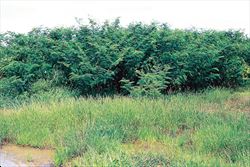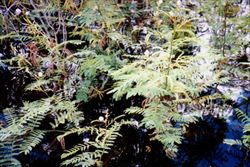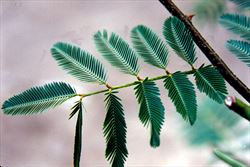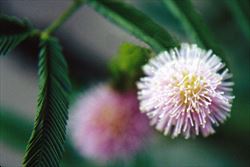Click on images to enlarge

terrestrial infestation (Photo: Land Protection, QDNRW)

aquatic infestation (Photo: Land Protection, QDNRW)

terrestrial habit (Photo: Land Protection, QDNRW)

aquatic habit (Photo: Land Protection, QDNRW)

aquatic habit (Photo: Land Protection, QDNRW)

prickly stem and twice-compound leaf (Photo: Land Protection, QDNRW)

close-up of flowers and flower buds (Photo: Land Protection, QDNRW)

close-up of globular flower cluster (Photo: Land Protection, QDNRW)

immature and mature fruit (Photo: Land Protection, QDNRW)
Scientific Name
Mimosa pigra L.
Synonyms
Mimosa asperata L.Mimosa asperata L. var. pigra Willd.Mimosa berlandieri A. Gray ex Torr.Mimosa brasiliensis Niederl.Mimosa canescens Willd.Mimosa ciliata Willd.Mimosa hispida Willd.Mimosa invisa Mart.Mimosa pellita Humb. & Bonpl. ex Willd.
Family
Fabaceae: sub-family Mimosoideae (New South Wales)Leguminosae (South Australia)Mimosaceae (Queensland, the ACT, Victoria, Tasmania, Western Australia and the Northern Territory)
Common Names
bashful bush, bashfulplant, black mimosa, catclaw mimosa, giant mimosa, giant sensitive plant, giant sensitive tree, mimosa, sensitive plant, sensitive tree, thorny sensitive plant, thorny sensitiveplant
Origin
Native to Mexico, Central America (i.e. Belize, Costa Rica, El Salvador, Guatemala, Honduras, Nicaragua and Panama), the Caribbean and tropical South America (i.e. French Guiana, Guyana, Surinam, Venezuela, Brazil, Colombia, Ecuador, Peru and northern Argentina). Possibly also native to large parts of Africa, Madagascar and Mauritius (or an early introduction to these places).
Naturalised Distribution
At present the distribution of this species is mostly limited to the northern parts of the Northern Territory. It has also been recorded more recently from the coastal areas of central Queensland (i.e. at Peter Faust Dam near Proserpine).
Also naturalised in tropical Asia (i.e. Cambodia, Malaysia, Singapore, Thailand and Vietnam), south-eastern USA (i.e. Florida), the Galapagos Islands and Hawaii.
Habitat
A weed of roadsides, waterways, drainage ditches, floodplains, swamps, seasonally flooded wetlands, lowland pastures and the edges of water bodies in wetter tropical and sub-tropical regions.
Habit
An upright (i.e. erect), much-branched, prickly shrub growing 3-6 m tall and forming dense thickets.
Distinguishing Features
- an upright prickly shrub with twice-compound leaves.
- its leaves often have small prickles on their stalks and consist of 6-16 pairs of branchlets, each bearing 20-45 pairs of small leaflets.
- these leaves are sensitive and fold together when touched or during the night.
- its flowers are pale pink or mauve in colour and arranged in fluffy globular clusters (10-20 mm across).
- its flattened, elongated pods are covered in bristly hairs and break up into about twenty one-seeded segments when mature.
Stems and Leaves
Young stems are greenish in colour, rounded (i.e. terete), have scattered prickles (5-12 mm long), and are covered with short stiff hairs. Older stems become woody and turn greyish in colour.
The twice-compound (i.e. bipinnate) leaves are alternately arranged along the stems and borne on stalks (i.e. petioles). These leaves (20-31 cm long) often have small prickles present along their main axis (i.e. petiole and rachis). They consist of several (6-16) pairs of branchlets (i.e. pinnae), each about 5 cm long and bearing numerous (20-45) pairs of small leaflets (i.e. pinnules). The leaflets (3-12 mm long and 0.5-2 mm wide) are elongated (i.e. lanceolate) in shape and stalkless (i.e. sessile). They fold together when touched and also during the night.
Flowers and Fruit
The flowers are pale pink or mauve in colour and arranged in fluffy, globular clusters (10-20 mm across). One to three (usually two) of these small flower clusters are produced on stalks (i.e. peduncles) 2-7 cm long, emanating from each upper leaf fork (i.e. axil). Individual flowers have four tiny sepals (0.75-1 mm long), four inconspicuous petals (2-3 mm long), and eight prominent pinkish stamens that give the flower clusters their fluffy appearance. Flowering occurs mostly during summer and early autumn.
The fruit is an elongated and flattened pod (30-120 mm long and 7-14 mm wide) that is covered in bristly hairs. The pods are borne in clusters (of 1-30), are straight or slightly curved, and are initially green in colour. As they mature they turn brown, and when fully mature they break up into about twenty (14-26) one-seeded segments. The seeds (4-6 mm long and 2-2.5 mm wide) are light brown, brown or greenish-brown in colour, elongated (i.e. oblong) in shape, and somewhat flattened (i.e. compressed).
Reproduction and Dispersal
This plant reproduces by seed and also vegetatively via adventitious roots and suckers from cut stems.
The seeds survive being eaten by animals and are often spread in this manner. The one-seeded segments also readily become attached to animals, vehicles and clothing and can be dispersed in water and mud.
Environmental Impact
Giant sensitive tree (Mimosa pigra) is regarded as a significant environmental weed in the Northern Territory, and as a potentially significant environmental weed in Queensland and Western Australia. This species is one of the 20 Weeds of National Significance (WoNS) in Australia, largely due to its impact on natural ecosystems, and is actively weed managed by community groups in the Northern Territory.
Legislation
This species is declared under legislation in the following states and territories:
- ACT: C4 - prohibited - a pest plant whose supply is prohibited in the ACT.
- New South Wales: Class 1 - a state prohibited weed. The presence of the weed on land must be notified to the local control authority and the weed must be fully and continuously suppressed and destroyed (throughout the entire state).
- Northern Territory: A - to be eradicated (in that part of the Territory south of 14ºS latitude), B - spread to be controlled (in that part of the Territory north of 13ºS latitude), and C - not to be introduced into the Territory.
- Queensland: Class 1 - introduction into the state is prohibited, and landowners must take reasonable steps to keep land free of this species (throughout the entire state). It is also illegal to sell a declared plant or its seed in this state.
- South Australia: 11+ - Class 11 is a category for those species that are 'Weeds of National Significance' but not otherwise declared in South Australia. Control of this species is not currently required in this state.
- Tasmania: D - the importation or sale of this species is prohibited and measures to reduce its population in an area, eradicate it from an area, or restrict it to a particular area may be required.
- Victoria: R - a restricted weed that cannot be sold or traded in this state.
- Western Australia: P1 - trade, sale or movement into the state prevented, and P2 - to be eradicated (throughout the entire state).
Management
For information on the management of this species see the following resources:
- the National Weeds Strategy Strategic Plan for this species, which is available online at http://www.weeds.org.au/docs/mimstrat.pdf.
- the Biosecurity Queensland Fact Sheet on this species, which is available online at http://www.dpi.qld.gov.au.
- the Northern Territory Department of Natural Resources, Environment and The Arts Agnote on this species, which is available online at http://www.nt.gov.au/weeds.
Similar Species
Giant sensitive tree (Mimosa pigra) is very similar to giant sensitive weed (Mimosa diplotricha var. diplotricha) and common sensitive plant (Mimosa pudica), which both also produce globular pink flower clusters. These species can be distinguished by the following differences:
- giant sensitive tree (Mimosa pigra) is a large shrub with an upright (i.e. erect) growth habit that has large much-branched leaves (i.e. 6-16 pairs of pinnae). It produces relatively large pods (3-12 cm long) that contain many (14-26) one-seeded segments.
- giant sensitive weed (Mimosa diplotricha var. diplotricha) is an upright (i.e. erect) shrub, creeper or climbing plant that has much-branched leaves (i.e. 4-9 pairs of pinnae). It produces relatively small pods (1-3.5 cm long) that contain a few (3-5) one-seeded segments.
- common sensitive plant (Mimosa pudica ) is a smaller plant, with a more low-growing (i.e. prostrate) habit, that has few-branched leaves (i.e. 1-2 pairs of pinnae). It produces relatively small pods (1- 2.5 cm long) that contain a few (1-5) one-seeded segments.

